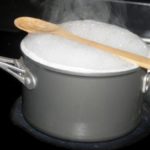Most wooden spoons are made from natural wood, so they do not have a negative impact on human health. Therefore, many families use them in cooking.
Not only for stirring and holding food, it also has another special function that makes cooking much simpler and safer. Just place a wooden spoon across the boiling pot?
Why should you place a wooden spoon across the boiling pot?
This little tip will help you be more proactive when encountering emergency situations of boiling water, minimizing the phenomenon of water spilling out of the pot.
When boiling water, especially bone broth, crab soup, soy milk, or even boiling water…, just a slight negligence will result in a lot of extra work to clean the kitchen because the water spills out, pouring all over the kitchen counter. Not to mention, the spilled food is also wasteful.
This phenomenon occurs because there is always a certain amount of air dissolved in the water. When you cook something and reach the boiling point, the increasing temperature will reduce the solubility and the hot water will quickly change from liquid state to gas state.
The bubbles formed when boiling water are the water vapor (gas) formed right inside the liquid. The higher the temperature, the more the gas escapes, sticking to the pot walls and floating to the surface of the water.
The longer it boils, the more the bubble layer increases on the surface until it spills out. That’s why you should place a wooden spoon across the boiling pot.
At this point, to prevent the food in the pot from spilling, place a wooden spoon on it. If the liquid in the pot starts to boil too high, the wooden spoon will prevent it from overflowing. The physical presence of the spoon will break the surface of the bubbles, preventing them from overflowing the pot.

Why should you place a wooden spoon across the boiling pot? It will help you avoid the situation of water spilling out and dirtying the kitchen counter. (Photo: AdobeStock)
Basically, bubbles will burst when they come into contact with something hydrophobic (water-repellent) and a wooden spoon is definitely suitable for breaking that layer of bubbles.
Moreover, wood is a poor conductor of heat and will only work for a limited time. Therefore, when in contact with the bubbles of water at 100 degrees C, the low temperature of the spoon will immediately condense the steam into water droplets, preventing them from continuing to rise.
This is in complete contrast to the reaction when using a metal spoon. Metal is a very good conductor of heat. When placed in the pot, it will start to heat up – sometimes even faster than the water in the pot. At that time, the water comes into contact with the smooth, hot surface of the metal spoon, bypassing the metal barrier and quickly spilling over.
However, you should note that if the water spills over multiple times, it will wet the wooden spoon, making it hot and gradually losing its effect. Therefore, after a certain period of time, you should return to turn off the stove instead of relying entirely on the stopping power of the wooden spoon. The longer the water boils, the bubbles will continue to form and the pot will boil again and spill out.
Note: To maximize the effectiveness of this tip, when placing a wooden spoon across the boiling pot, you should choose a large-sized spoon. In general, this tip applies to all cooking cases where water and bubbles easily overflow from the pot. If you need to leave for a short time, you can apply this little tip.






































